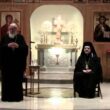Every year on the 27th of March, at two days after the great glorious holy feast of Annunciation, our Orthodox Church reminds us of the celebration of the Icon of the Holy Mother of God called `The Sweet Kiss` (or Glykophilousa), one of the Icons of the Most Holy Mother of God with a very interesting story, which we propose you to discover in the lines from below.
According to the tradition of our Church this Icon of the Holy Mother was painted by Saint Luke the Evangelist, who after the moment of Pentecost painted the first icons of the Holy Mother of God.
Afterwards about 70 Icons of the Holy Mother of God were painted by Saint Luke the Apostle and Evangelist and after these icons were made many early copies some of them being preserved until our times, thing which happened with the Icon of the Holy Mother of God Glykophilousa.
The name of the Icon – Glykophilousa – comes from Greek being composed of the terms `glycό`, which means `sweet` and `philoúsa`, from the verb `philein` which means `to love` and `to kiss`. Thus the name of the icon is translated by `The sweet kiss` being sometimes translated as `The sweet loving one`
The story of the Icon of the Holy Mother of God `Glykophilousa`goes back in time until the iconoclast age (between the years 726-843), when the iconoclast Byzantine emperors forbid the worshiping of the icons and moreover they ordered their destruction and the punishment of those who worshiped them. The name of this religious and political movement comes from Greek, from the words `eikon`(image or look) and `klasma` (to destroy).
According to the tradition of our Church, the first Icon `Glykophilousa` belonged to a pious Christian woman from Constantinople whose name was Victoria. Her husband had the rank of senator and supported the emperor Teophilus the Iconoclast (829-842) in his action of combating the worshiping of the holy icons.
One day, returning from the imperial court, Simeon told his wife that the soldiers entered the houses of the people to search if they had icons and if they found them they burnt them and reclaimed those people to the emperor.
Out of her wish to protect the icon of that thoughtless desecration, Victoria covered the icon and went in secret on the seashore where she immediately put it on water, praying tearfully and being amazed of what she saw: the icon stood vertically and was floating like a feather above the waves. Floating offshore the Sea of Marmara, the icon went on the Aegean Sea approaching the shore of Philotheou Monastery
One night the Holy Mother of God appeared to the abbot of the community from Philotheou and ordered him to go to the seashore and he would find a priceless treasure to the joy and blessing of all of them.
Waking from his sleep, the abbot took with him some monks and descending in a rush on the seashore they found the Icon shining in a flood of dazzling light.
The abbot went into the sea and took the Icon in his hands and when he stepped back on the shore from the rock where they put it a potable spring burst out and this exists even nowadays. According to the tradition of the monastery, the Christians who prayed before this Icon and drank from the holy water of the Holy Mother of God `Glykofilousa` received a good answer from Christ by the intercession of His Mother being healed diseases and being born children after long periods of wait. Annually on the second day of Easter after the tradition dating from the old times the community from Philotheou Monastery goes in a procession with this Icon of the Holy Mother of God until this spring in the remembrance of the special moment when the Icon was discovered by the ancestors of the monastery.
From the point of view of the ecclesiastical art, the icon of the Holy Mother of God `The Sweet Kiss` belongs to the `Glykofilousa` iconographic type. This type presents Christ, the Holy Infant, with His face closely touching the face of the Holy Mother of God in a loving gesture.
The painters say that in this Icon the Holy Mother of God seems to embrace tighter the Saviour in comparison with other iconographic representations, her own facial look being one which expresses a strong affection.
The pilgrims who come to the Holy Great Monastery of Philotheou can bow before the Icon of the Holy Mother of God Glykophilousa, finding it on the left side of the katholikon of the Monastery, placed on the iconostasis.
Source: http://blog.bizanticons.ro








